Notice: Undefined variable: page in /home/vrxdg1855sn3/public_html/wp-content/themes/72tree/content.php on line 15
Notice: Trying to get property 'ID' of non-object in /home/vrxdg1855sn3/public_html/wp-content/themes/72tree/content.php on line 15
4 Shrub Species for Your Alpharetta Georgia Yard
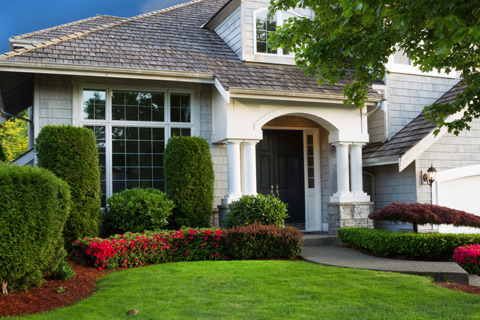
Trees, flowering shrubs, bushes, plants, and grass all work together to create a diverse ecosystem above and below the ground. While birds, insects, and other wildlife are attracted to the foliage, refuge, and blooms above, the roots are working below to find water, nutrients, and stability.
Choosing the right shrubs for your Alpharetta Ga landscape is a question of selecting ones that will thrive in the conditions of the environment where they are planted.
The team at 72tree.com has identified 4 shrub specimens that will enhance the natural beauty of your Alpharetta yard and landscape.
Hardiness Zone 7b Bushes and Shrubs for Alpharetta
The USDA Hardiness Zone Map divides North America into 11 planting zones. Each individual planting zone is around 10°F colder (or warmer) than its neighboring zone –during an average winter.
At your local nursery or garden supply store, plant identification tags usually identify the zone in which that species will thrive.
The city of Alpharetta is located in zone 7b with a humid subtropical climate which supports the following striking species:
Juniper – juniperus
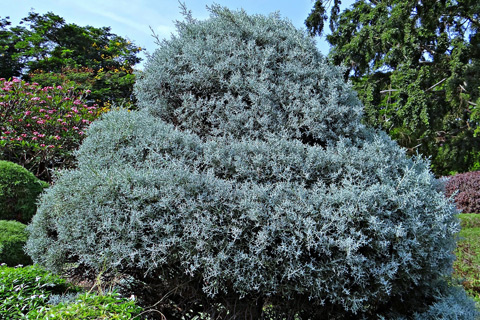
Junipers are long lived, slow growers, and rarely die. With a strong and extensive root system, they are able to adapt to their surrounding environment with ease. When planted in a location with ample space for growth, this specimen requires very little attention.
Juniper varieties vary in shape and size. The taller of the species can reach heights of more than 130 feet at maturity. The majority of the species however, are slow growing and will only reach about 30 feet in height, or 3 feet in diameter at maturity.
Junipers are evergreen and while they do not produce flowers or fruit, they do produce seeds.
Under the right conditions, this species can live from 400 to 700 years.
They are vulnerable to rust disease, which can be managed through pruning affected areas and treating them with fungicides.
Mountain Laurel – Kalmia latifolia
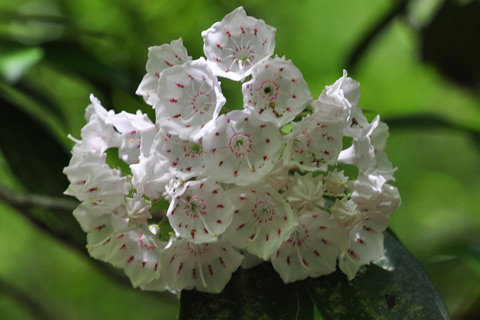
Mountain Laurels are relatively fast growers when properly planted. With a matted spreading root system, this shrub grows well in acidic well drained soil, and thrives when grown on north facing slopes or the east side of structures.
Mountain Laurel varieties are able to reach upwards of 25 feet, and if left to thrive without pruning, can grow into a large blooming thicket. Prolonged direct sunlight in summer months can stress this species. Take this into consideration when choosing its location.
This species is evergreen and produces flowers in terminal trusses of 50 to 150 blooms. Blooms range in color from white to pink and deep rose commonly with purple details. Flowering occurs in late spring (May and June).
This shrub however, is toxic. All of the green components – including the flowers, pollen, and twigs – contain andromedotoxin and is poisonous when ingested. If browsing animals consume enough of the plant, it can be lethal.
Mountain Laurel is vulnerable to leaf spot which can be managed through pruning affected areas and then treated with fungicides.
Rose of Sharon – Hibiscus Syriacus
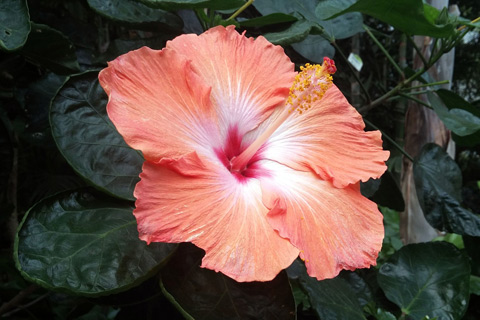
Rose of Sharon can be planted as a small tree or large shrub. It grows well in varied soil types but performs best in hot climates with moist soil and full sun.
At maturity, this species can reach up to 12 feet tall and grow 10 feet wide. Being multi-stemmed with vertical branches, it is relatively easy to grow, and requires minimal care. For this trait, Rose of Sharon is commonly used as hedging.
Rose of Sharon is a deciduous flowering shrub which with heavy pruning in early spring promotes flowering from July through September. Its flowers reach 2 to 4 inches in width, and blooms can range in color from pink, red, purple, white, and blue with a typically red center.
This species, if left unchecked, will reproduce and spread quickly in areas with little disturbance. Rose of Sharon is a vigorous and healthy species with high tolerance to pests and disease. When there is a problem with either, it is easily remedied through heavy pruning and with insecticides or fungicides.
Gardenia – Gardenia jasminoides
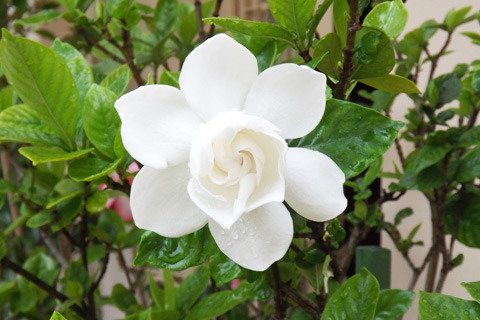
Gardenia can be planted as a small tree or large shrub. It thrives in acidic soil with good drainage, and flourishes in high humidity. This shrub grows best with night temperatures above 60 degrees, and mid to low 70’s during the day. Bright (not direct) sunlight is best for this species.
This shrub can typically grow up to 15 feet but some varieties are able to reach heights of 50 feet tall. With its many size and form variations, they are frequently used as hedges, ground cover, and even specimen plantings.
Gardenias are evergreen flowering shrubs and small trees that do require moderate attention and care. Flowering from April through July, the flowers can be solitary or in clusters; they range in color from white to pale yellow.
One of the greatest features of growing gardenias is its sweet scent. Once the species blooms however, the flowers quickly wilt when they come in contact with water.
Gardenias are highly susceptible to pest infestations. However, they can be easily managed with insecticidal soaps or horticultural oils. It also helps to maintain a high level of biodiversity in your garden which serves to attract predators of the insects threatening your garden.
Benefits of Shrubs Around Trees
Besides all of the artistic possibilities that come about on a landscape rich with trees and shrubs, during severe weather and strong winds, it is your shrubs and bushes that act as a wind buffer.
Shrubs and bushes do an excellent job at diverting wind, thus weakening it. This in turn spares the surrounding trees from taking the full force of potentially damaging winds.
Likewise, the bushes planted around your home will help shield it when the cold winter winds begin to blow.
Healthy Gardens and Landscapes Need Diversity
A healthy garden and landscape will have a variety of thriving tree, plant, and shrub species. Throughout the blooming season, as each species flowers, it attracts different insects and wildlife.
This biodiversity helps to stave off infestations. Likewise, the co-mingling of roots and fungi (in fertile soil) help to create a thriving mycorrhizal network below the soil that works to impede invasive diseases.
Remember to have a plan in mind when acquiring plants and shrubs for your garden and landscape. Not all shrubs can be planted equally, but they all can thrive in the right environment.
Sources:
http://buckjones.com/trees-shrubs-how-to-choose/
https://www.michigandnr.com/publications/pdfs/huntingwildlifehabitat/Landowners_Guide/Resource_Dir/Acrobat/Trees_and_Shrubs.PDF
http://www.lot-lines.com/5-reasons-to-reconsider-your-hatred-of-juniper-bushes/
https://en.wikipedia.org/wiki/Kalmia_latifolia
https://extension.psu.edu/mountain-laurel-diseases
https://www.uaex.edu/yard-garden/resource-library/plant-week/mountain-laurel-6-15-12.aspx
http://www.hort.uconn.edu/plants/detail.php?pid=204
https://communityenvironment.unl.edu/plant-month-rose-sharon
http://homeguides.sfgate.com/rose-sharon-tree-41486.html
http://gardeningsolutions.ifas.ufl.edu/plants/ornamentals/gardenias.html
https://en.wikipedia.org/wiki/Gardenia
https://plants.ces.ncsu.edu/plants/all/gardenia-augusta-g-jasminoides/
Notice: Undefined variable: page in /home/vrxdg1855sn3/public_html/wp-content/themes/72tree/content.php on line 15
Notice: Trying to get property 'ID' of non-object in /home/vrxdg1855sn3/public_html/wp-content/themes/72tree/content.php on line 15
Trees, Shrubs, and the USDA Hardiness Zone Map
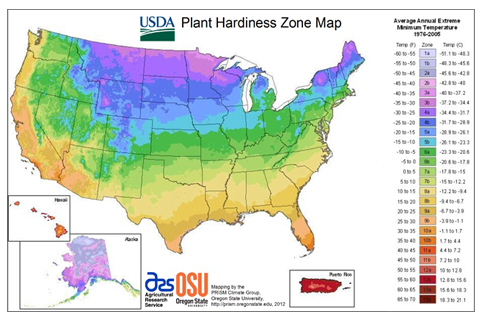
If you have ever gone into the nursery and picked a plant or tree, later to realize it was not suitable to be planted in the environment in which you live, this can be avoided. Besides the scientific plant name and care instructions, you will notice the hardiness zone printed on its tag.
The USDA Hardiness Zone Map splits North America up into 11 separate planting zones. Each individual planting zone is around 10°F colder (or warmer) than the adjacent zone during an average winter. If you’re reading a plant description in a gardening magazine and you see a mention of a hardiness zone, then it’s likely referring to the USDA Hardiness Zone map.
What are Hardiness Zones?
A hardiness zone is based on average annual extreme minimum temperatures across a 30-year period. It’s not based on the lowest recorded temperature in a region or what might possibly happen in the future. Gardeners must keep this in mind as they choose plants and trees, especially if they are planning to “push” the hardiness zone they live in by planting trees and plants not suited for that particular hardiness zone. Something else to keep in mind is that there could be microclimates that won’t show up on a map – even one as detailed as the current USDA PHZM map.
Eastern Zones vs Western Zones
Eastern Zones – The USDA map is great at its job of outlining the different gardening climates of the eastern half of North America. This is a comparatively flat area, which means it can be mapped out by drawing lines approximately parallel to the Gulf Coast around every 120 miles as you progress north. The lines will start to tilt northeast as the Eastern Seaboard approaches. The USDA map also accounts for the special climates caused by the Appalachian mountains and the Great Lakes.
Western Zones – A range of factors including winter lows, elevation and precipitation determine the growing climates in western North America. The weather in the west floats in from the Pacific Ocean, becoming less humid as it moves around the mountain ranges to the west. The growing climates in the west can vary quite a bit compared to the east, where cities in similar zones can grow the same plants in the same climates. The weather – and the plants that can be grown in it – in coastal Seattle are much different than what you can expect in the higher and more inland Tucson, Arizona. This is in spite of both cities being a part of zone 8 of the USDA map.
To find the zone for where you live, see http://planthardiness.ars.usda.gov/PHZMWeb/
Ideal Trees and Shrubs for Alpharetta and Roswell Ga
Many of our customer’s aim to improve their well-manicured yards with trees, shrubs, and flowers. Of course the right sunlight, soil, and moisture conditions are factors needed for these plants to flourish. After being asked for specific species, we created a short list of popular trees and common shrubs that will thrive in Alpharetta and Roswell Ga. 7a and 7b are the zones for North Georgia, so next time you visit the nursery, be sure to look for plants that are conducive to living in these zones.
Other Factors to Consider with the Hardiness Zone Map
There are other environmental factors that determine whether a plant succeeds or fails on top of the hardiness zones. Wind levels, soil type and moisture, humidity, pollution, winter sunshine, and snow are all major contributing factors to plant survival. Whether or not a plant survives can also depend on where it is planted, how it is planted, their size, and their overall health.
The map was most recently updated in 2012 when the USDA adjusted the plant hardiness map to account for the warmer global temperatures occurring over the past thirty years. Refer to this resource when purchasing trees and plants for your garden and landscape.
Interactive Map: http://planthardiness.ars.usda.gov/phzmweb/interactivemap.aspx
Notice: Undefined variable: page in /home/vrxdg1855sn3/public_html/wp-content/themes/72tree/content.php on line 15
Notice: Trying to get property 'ID' of non-object in /home/vrxdg1855sn3/public_html/wp-content/themes/72tree/content.php on line 15
5 Common Shrub Species Found in Alpharetta Ga
When speaking of Atlanta suburbs, the city of Alpharetta is sure to steal the conversation. One striking trait in this suburb is the abundance of trees, shrubs and well-manicured yards. While there are dozens of attractive plants we could share, our arborist explains characteristics of 5 shrubs that are sure to impress and perfect for your Alpharetta Ga yard.
Characteristics of 5 Shrubs That Are Ideal for Alpharetta Yards
Plants, trees and shrubs require certain conditions to thrive and grow into healthy specimens. Knowing the watering, sunlight and soil requirements of a shrub will help ensure it develops properly.
Our Alpharetta tree removal and planting experts are available to help you choose the ideal shrubs and trees for your yard. However, these 5 shrub species develop nicely and are commonly planted by residents of Alpharetta.
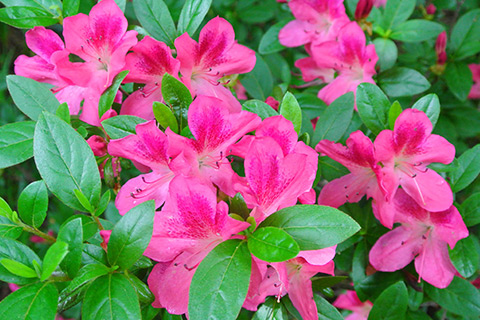 Rhododendron – With the ability to reach a height of 15 feet or more, your hedge solution is at hand. Rhododendron is the national flower of Nepal – Ask your friends where that is! The conversation alone makes this stunning species worth it!
Rhododendron – With the ability to reach a height of 15 feet or more, your hedge solution is at hand. Rhododendron is the national flower of Nepal – Ask your friends where that is! The conversation alone makes this stunning species worth it!
Planting on the North side of a building – protecting it from morning sunlight is optimal for this species. Overwatering will cause a waterlogged root system that may lead to plant failure, while under watering can also damage these shrubs. Fertilize annually in the fall or early spring for best results.
Blooming from the end of winter through early summer, there is an added bonus to having this shrub. Hummingbirds will be racing through your landscaping attracted to the blooms. Thus, adding one more element of desirability to choosing a Rhododendron.
Florida Anise – With fruit shaped like a star, Florida Anise has been popularly dubbed as Star Anise. This evergreen shrub grows to a whopping 10 to 12 feet in height and 5 to 8 feet wide. It thrives in rich and moist soil being best suited for shade with morning sun. However, this beauty – once established – possesses a high tolerance to drought conditions.
A fun snippet about the Florida Anise is that it protects itself with poisonous aromatics in the foliage deterring animals and insects from making it a meal.
Camellia Japonica – Commonly known as ‘Rose of Winter’ – its Alabama’s state flower. With thousands of cultivars having varied colors and forms of flowers, creating diversity in the landscape will be a cinch.
This stunner blooms in winter and early spring and thrives in a semi-shade environment with moderate to regular watering. Given the ideal conditions, just sit back and be amazed at just how beautiful this shrub can be.
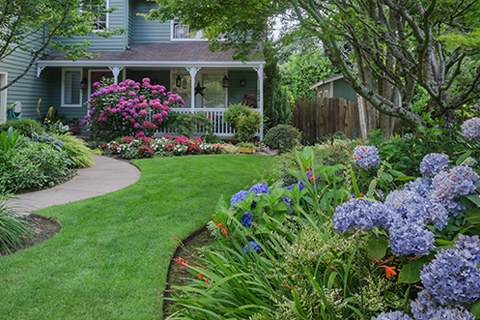 Hydrangea – If strength combined with beauty is your aim, the Hydrangea is certainly the right pick for your yard. Well known for its large, circular blooms, it steals the show by staying in bloom from the beginning of spring to late fall. That’s right, while the others are full of nakedness, the Hydrangea keeps putting on a show.
Hydrangea – If strength combined with beauty is your aim, the Hydrangea is certainly the right pick for your yard. Well known for its large, circular blooms, it steals the show by staying in bloom from the beginning of spring to late fall. That’s right, while the others are full of nakedness, the Hydrangea keeps putting on a show.
Location is key. You will want to protect your Hydrangeas from strong winds and hot afternoon sun – planting them on the East side of a building will help create a shaded afternoon. Overwatering will cause the roots to rot, killing the shrub. In the beginning, an all purpose slow-release fertilizer are helpful in ensuring a strong start to an incredible shrub!
Those beautiful blooms come in an array of colors including; white, blue, pink lavender and rose – at times with multiple colors on the same shrub. This color variety occurs with the pH level of the soil, however, the white bloom is unaffected by this factor.
Fatsia Japonica – If you are looking to fill a spacious area with an explosion of green, look no further! This evergreen shrub – native to Southern Japan and South Korea – reaches an astounding 10 to 20 feet tall with its leaves spiraling up its branches creating beautiful symmetry.
Medium to full shade with compost rich and moist soil is a winning ticket for the Fatsia Japonica. A semi-protected location is important, as strong winds and excessive sunlight tend to damage the foliage. Fertilize annually with a tree and shrub fertilizer in the spring.
Sometimes referred to as the ‘Paper Plant’, its small white flowers make an appearance in late fall and early winter. Those same flowers give way to a small black fruit. This shrub makes for an excellent conversation piece in a well-structured garden.
Use Shrubs to Improve the Appeal of Your Landscape
In addition to the striking colors, the addition of healthy shrubbery to a landscape cannot be overstated. Properly planted and arranged shrubs will help prevent soil erosion and in many cases, raise the property’s curb appeal!
Whether it’s filling in the gaps or structuring a hedgerow, the aforementioned shrub species are sure to create an impressive and practical landscape. Familiarize yourself with the conditions of your yard, then choose the best suited shrub for a beautiful addition to your landscape.
Notice: Undefined variable: page in /home/vrxdg1855sn3/public_html/wp-content/themes/72tree/content.php on line 15
Notice: Trying to get property 'ID' of non-object in /home/vrxdg1855sn3/public_html/wp-content/themes/72tree/content.php on line 15
Tree Pruning – Why, How & When to Prune Your Trees
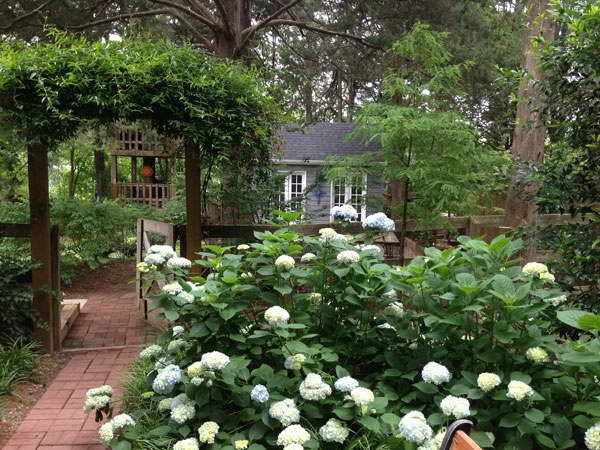 Tress help improve the overall look and value of your property, but they need to be pruned or trimmed regularly for various reasons. Often branches have to be cut off for public safety and equally important the tree’s health.
Tress help improve the overall look and value of your property, but they need to be pruned or trimmed regularly for various reasons. Often branches have to be cut off for public safety and equally important the tree’s health.
Tree Pruning – Why Do It?
There are many different reasons to prune a tree, the first being safety. Weather affected trees and dead branches fall often and should be removed to decrease liabilities. Another safety related reason to prune trees is to remove any visual traffic obstructions or low-hanging branches that people might walk into.
Trees should also be trimmed for building upkeep and preservation. Paint and even minor structural damage may occur from foliage and limbs rubbing, touching, or compromising a structures foundation. Also, insects and critters can use these as entry points and it may increase the occurrence of mosquitoes and insects in the environment.
A counterintuitive lesson is that trees should be trimmed to boost their development, growth and structure. Healthy trees generally have good foliage density but their interior is not overcrowded. Fruit trees usually undergo structural pruning; this process results in helping them cope with the additional weight of the fruits that are produced.
Aesthetics is another suitable reason to prune trees. Obviously, poorly maintained or unsightly trees remove from the beauty of a property, making it feel less hospitable. Trimming and pruning is a simple method to improve the visual appeal of a tree.
If a tree needs to be pruned because it poses a threat, it’s best to call an arborist or tree removal company. Since a main goal of trimming a tree is personal safety, it’s best to hire a tree professional to trim and properly inspect your trees for any damage, pests or disease.
The following are guidelines for when you need to call a tree professional:
• Trees near a utility line shouldn’t be pruned by anyone but a professional arborist; getting near power lines is too dangerous and risky, especially when falling limbs or trees are involved.
• Trees smaller in diameter aren’t as dangerous, but a local tree service should handle trees greater than 10cm.
*Note – An important consideration is whether your city or local municipality has a tree ordinance or permit process for pruning your trees. Check with your local arborist division so you avoid a potential citation or fine.
How to Prune – Types of Cuts
The two basic types of pruning or tree trimming cuts are thinning cuts and heading cuts. Thinning cuts remove limbs at the point of their origin or attachment. In other words, when a branch is pruned at the point it connects to another branch, or from the trunk, it’s called thinning. The benefits of tree thinning are less wind resistance, improved air circulation, and less crowding, which improves sunlight penetration.
Heading cuts on the other hand reduce a tree’s height. When performing heading cuts, or “topping” the tree, you are cutting lateral branches and any terminal branches. Heading cuts encourage growth of buds nearest to the cut. Heading cuts shouldn’t be used on branches older than a year so as to avoid stimulating suckers and water sprouts. Likewise, on older trees heading is also referred disfigures and leaves them susceptible to pests and disease. Topping is not an ideal method of pruning because long-term it may destroy a tree by making it susceptible to rot.
Insects and bacteria exist in every environment and can be disastrous to a tree. So it’s important to note that not pruning in warming months is the best way to avoid tree disease and insects from destroying a tree.
When to Prune – Trees and Shrubs
Knowing when to prune depends largely on your goal and objective to be achieved. As a good rule, the best time to prune is late winter to early spring, when the tree is dormant. Limb removal will not be as stressful to the trees since the tree is inactive.
Other reasons to prune at this time include: Wounds seal better, and reduction in pest infestation risk as diseases and insects are inactive. On the other hand, non-flowering shrubs can be pruned as the need arises to maintain or accomplish a specific shape. Flowering shrubs should be pruned as soon as they finish blooming.
Late spring and early summer is the worst possible time to trim trees as this is when leaves expand and the tree’s entire energy source is being put towards its new growth.
When pruning its best to leave the bottoms wider, which allows sun to get to the bottom of the shrub. This will prevent the shrub from excessively thinning out. Lastly, late summer pruning may encourage new growth. This is bad because it may not have sufficient time to harden and be ready in time for winter.
Pruning is critical to the health of your shrubs and trees. However, using the above measures can prevent stress and help your trees survive the cold season. Contact our tree inspection and tree care specialists for pruning, trimming or diagnosing your trees – (678) 223-5495.
